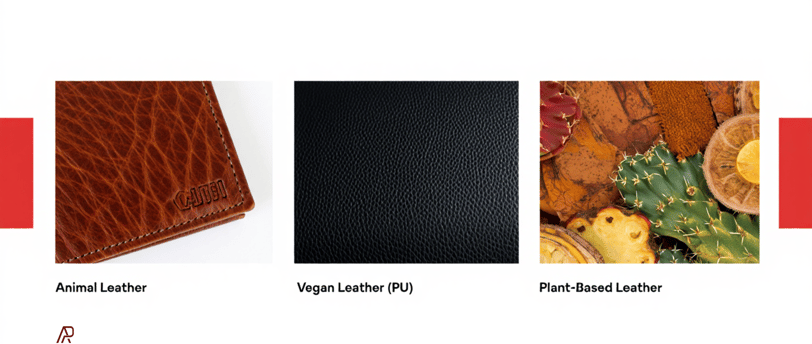Animal Leather, Vegan Leather, Plant-Based Leather: What You Really Need to Know
Between ethical concerns, eco-marketing, and conflicting claims, the word “leather” has become confusing for many buyers. Not all leather is created equal — and not all so-called “eco” options are as green as they seem.
Anthony Zanfanti
4/30/20252 min read


Animal Leather, Vegan Leather, Plant-Based Leather: What You Really Need to Know
Between ethical concerns, eco-marketing, and conflicting claims, the word “leather” has become confusing for many buyers. Not all leather is created equal — and not all so-called “eco” options are as green as they seem.
In this article, we break down the differences between animal leather, vegan leather, and plant-based leather, to help you make an informed, responsible choice.
Animal Leather: Traditional, Durable… and Controversial
Animal leather is the traditional material used for centuries in bags, shoes, clothing, and furniture. It typically comes from:
cows (most common)
calves (softer, finer grain)
goats, sheep, buffalo
and sometimes pigs, deer, or fish (less common)
Most of this leather is a by-product of the meat industry. It’s treated (tanned) to become resistant, flexible, and long-lasting.
Pros:
strong, breathable, and highly durable
develops a natural patina over time
repairable and designed to last
Cons:
animal origin can be an issue for some
environmental impact tied to livestock farming
pollution risk if chrome tanning is poorly managed
Vegan Leather: Better for animals, not always for the planet
“Vegan leather” has no official or legal definition. In most cases, it refers to a leather alternative that contains no animal material — but don’t be fooled: it’s usually plastic.
The most common form? Polyurethane leather (PU), a synthetic material derived from petroleum.
PU leather visually mimics animal leather, but contains no natural fibers.
Pros:
no animal products
cheaper to produce
easy to dye and manipulate
Cons:
made of plastic, non-biodegradable
petroleum-based: high environmental cost
shorter lifespan (can crack or peel over time)
Despite its name, vegan leather is often seen as eco-friendly, but it’s actually an industrial material made from fossil fuels.
Plant-Based Leather: A Greener Alternative?
Let’s be clear: plant-based leather is not the same as vegetable-tanned leather (which is still animal leather).
Plant-based leather is made entirely or partially from plants.
Some examples:
Pineapple leather (Piñatex) – made from pineapple leaf fibers
Apple leather – made from apple processing waste
Grape, cactus, or mushroom-based leather (mycelium)
Most of these materials are hybrid compositions, combining natural plant fibers with synthetic binders (like PU or latex).
Pros:
renewable sources, often from agricultural waste
strong ethical and eco-conscious branding
exciting innovation potential
Cons:
often mixed with plastics for strength
still less durable than quality animal leather
expensive and not yet widely available
Bottom Line: What Should You Choose?
Vegan leather is often marketed as ethical and eco-friendly — but in reality, it’s usually plastic made from oil.
Animal leather, while controversial for ethical reasons, can be a sustainable option when responsibly sourced and tanned.
Plant-based leather is promising, but many materials are still in development or require synthetic binders to work.
At APECS, we’ve chosen to work with high-quality animal leather that’s responsibly tanned, made to last, and designed to age beautifully — like the one featured in our connected leather laptop bag.
